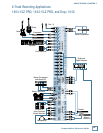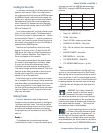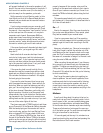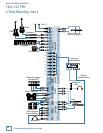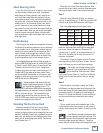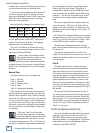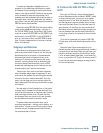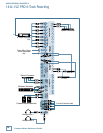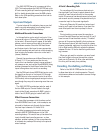
75
Compact Mixer Reference Guide
APPLICATIONS: CHAPTER 2
To create an independent headphone mix, for
example, for the lead singer that’s heavy on vocals
and bass but has just enough of the drums so he can
keep in time, adjust the AUX 2 knobs on the recorder
return channels to make the singer happy. You’ll
probably want that headphone mix to be pre-fader so
the singer doesn’t hear any tweaks that you make to
your control room mix while he’s singing, so press the
PRE buttons on those channels.
Since we’re using RETURN 2 for the reverb, adding
reverb to the headphone mix is easy – just turn up
the TO AUX SEND 2 knob. On the Onyx 1640, there’s
a control to send AUX RETURN 2 to AUX SEND 6 (as
well as one to route RETURN 1 to the AUX SEND 5
bus) so if you have an Onyx, use AUX SEND 6 rather
than 2 for your headphone mix if you want to add an
effect in the phones.
Subgroups and Submixes
We’ve shown how subgroups can be used to mix
several tape tracks down to one or two, but they can
also be used to mix live inputs. In these examples
we’ve used a stereo drum machine for our drum
tracks, but if you have a real drummer with a real
drum kit, you may choose to set up several mics on
the drums, assign those channels to a pair of SUB
busses, and use subgroups to mix those mics to two
channels, which you’ll send to the recorder.
Connect your drum mics to the lower numbered
mixer channels, assign them to subgroups 1-2, and
record as in the example. By monitoring the recorder
returns for the drum tracks (channels 9-10 on the
mixer) you can hear your drum mix and adjust the
faders, pans, and EQ on the input channels for a good
drum sound.
You may want to initially devote four or fi ve tracks
to drums, and if necessary, mix those down with the
rest of the rhythm section on a bounce pass. Typically
when working with fewer than 16 tracks, the kick
and snare get their own tracks, with toms, cymbals,
and overhead mics mixed to two other tracks.
This same technique works well when you’re
recording large groups – a string or horn section, or a
vocal chorus – as part of a multitrack project. Assign
the mics to a pair of subgroups and record the sec-
tion as a stereo pair of tracks.
16 Tracks on the 1604-VLZ PRO or Onyx
1640?
Sure, why not? After all, they’re sixteen channel
mixers. Remembering that a channel INSERT is both
an output and an input, you can put up to sixteen
recorder tracks “in line” with the channels. The In-
sert Send gives you one mic preamp output to every
track, and the Insert Return is a line-level input for
every channel. On the Onyx, you can use the direct
Recording outputs to feed the recorder straight from
the mic preamps, then use the Insert Returns with
a trick plug to monitor the outputs of the multitrack
recorder.
If this isn’t a big enough hint, see the 1202/1402
8-Track setup for a more detailed description of this
setup.
Using the Insert Outputs connected to up to
sixteen recorder tracks is an excellent way to make a
live recording of your band. When you get home, just
patch the recorder outputs to the mixer line inputs
(or for an even cleaner signal path, to the Insert Re-
turns – just push the 1/4" plug in all the way) and it’ll
be just like you were there playing on stage, directly
into the microphones.



